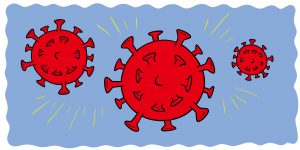The end of the pandemic appears close—if you live in a wealthy, Western country. As of April 19, all U.S. adults are eligible to receive a vaccine, and approximately 30 percent of the U.S. population is fully vaccinated. Forty-three percent have received at least one dose. While President Biden announced that life should return to normal by early July, the outlook for the rest of the world is less hopeful. Currently, countries representing just 16 percent of the world population have purchased 60 percent of the world’s COVID-19 vaccination supply. In stark contrast, forecasts predict that the world’s poorest countries will not be fully vaccinated until 2024.
Unless countries start donating their surplus vaccines as soon as possible or license patents to create more vaccines, COVID-19 will continue to run wild, killing thousands, overwhelming already weakened healthcare systems, and mutating into more dangerous variants. As seen recently in India, a country faring considerably well can quickly run into turmoil. With their national vaccine campaigns well underway, it’s time the U.S. and other Western countries start to fulfill their responsibility to vaccinate the rest of the world. It’s a moral imperative, as well as a public health necessity.
The biggest threat of delayed global vaccinations is the possible emergence of more infectious variants. With new variants emerging in Brazil, South Africa, India, and the U.K., it is clear that there is no way to predict where the virus might turn and whether the current vaccines will be effective against the mutated strains. Each of the variants has appeared in more than one country, and some are thought to be more contagious due to changes in the virus’s structure.
The most effective way to gain global control of the virus would be to start vaccinating people in every country, rather than trying to reach 100 percent protection in only a handful. By insisting on vaccinating their populations before sharing access to vaccines, Western countries are endangering the entire world’s ability to gain control of the virus and stay ahead of new developments.
Consider India, a country that did not expect to have a second wave of COVID-19 infections due to a high level of acquired immunity and a national vaccination campaign. It’s believed that the combination of lower levels of immunity than previously estimated, renewed large gatherings, and new variants has fuelled the record breaking new wave of infections. The B.1.1.7 variant of the virus—estimated to be 40 to 70 percent more contagious than previous strains—first found in the U.K., is now the dominant strain of the virus in some parts of India. So far, the number of people infected after being vaccinated remains low, suggesting that vaccines are still effective against the variants spreading in India.
India has increased its vaccination drive in an effort to combat the rising cases. Currently, the AstraZeneca and Bharat Biotech vaccines are being used. The country has recently stopped exporting doses of the AstraZeneca vaccine manufactured by the Serum Institute of India to help vaccinate its own population quicker. Unfortunately this action has significant consequences for the global vaccine supply, as the Serum Institute is a major supplier of vaccines to the developing world. In addition to stopping exports, India has sought to import more vaccines to support its large population.
As countries vie for vaccine doses, some are looking for ways to expand the global supply. In October 2020, South Africa and India asked the World Trade Organization (WTO) to waive some provisions in international agreements that protect intellectual property (IP) rights in order to allow production of COVID-19 vaccinations to be scaled up to address global needs. The U.S. and EU both blocked the proposal as some vaccine makers claimed they needed to enforce the patents and protect their IP in order to fund the expensive research that leads to such developments.
It has been estimated that the minimum cost of producing a vaccine for a disease similar to COVID-19 would be $2.8–3.7 billion. However, in an article written for Foreign Policy, members of the O’Neill Institute for National and Global Health Law at Georgetown University claimed that vaccine makers have already recouped their investments due to a large amount of public funding. Therefore, there is no need for the vaccine makers to protect their IP for economic purposes in this situation.
Nevertheless, there are still concerns about the effects of suggestions such as compulsory patent licensing on long-term innovation. While there are undeniable benefits to licensing patents to combat COVID-19, if compulsory licensing becomes the default to fight every global health crisis, there will be little incentive for companies to continue researching and developing new drugs. One suggestion to combat this is that companies should be paid extra to share their IP with other manufacturers; however, this would increase the price of vaccines, making them even less accessible to poor countries.
As an alternative to sharing patents, the U.S. and EU donated money to COVAX, a vaccine sharing scheme co-led by the WHO and public-private organizations like CEPI and Gavi whose missions are to expand global vaccine access. COVAX aims to vaccinate at least 20 percent of each participating country this year, well below the threshold needed for herd immunity. Furthermore, these monetary donations are less helpful given that Western countries are buying vaccines directly from manufacturers, jeopardizing the ability of COVAX to procure a sufficient number of vaccines. By continuing to prioritize national interests and protections for pharmaceutical companies, Western countries are actively ignoring their responsibility to help vaccinate the rest of the world until they have secured their own populations.
Many countries have promised that once they finish vaccinating their own citizens, excess vaccines will be donated to other countries, but they might not get there fast enough. For example, the U.S. has a massive stockpile of AstraZeneca vaccines that is continuing to grow. On April 26, the U.S. shared plans to share the entire stockpile following safety checks. This is a step in the right direction, but distribution will be key. The best way to ensure equitable global access to vaccines would be to donate through COVAX. While it is certainly beneficial to some nations to donate to specific countries and engage in vaccine diplomacy, the best way to vaccinate the world would be to distribute vaccines to as many countries as possible.
WHO Director-General Dr. Tedros Adhanom Ghebreyesus wrote in a piece for The Guardian that a “me-first approach might serve short-term political interests, but it is self-defeating and will lead to a protracted recovery, with trade and travel continuing to suffer.” The estimated economic cost of the pandemic in the U.S. is already predicted to reach $16 trillion, or the equivalent of “a hurricane hitting the whole country.” If new variants emerge that can overcome available vaccines, it’s possible that countries will incur even more costs as they figure out how to tackle the virus once again.
This is all to say that the quickest way to end the pandemic is to get as many people vaccinated as quickly as possible. It’s important for people in Western countries with access to vaccines to get vaccinated, not only to protect themselves and their communities, but also so that their governments no longer have an excuse to hoard excess vaccines. It’s not only a public health necessity, but a moral imperative to vaccinate the world as quickly as possible. In the time that it will take for Western countries to finish their national vaccination campaigns, thousands of people across the world will die as COVID-19 continues to spread through their countries. This pandemic won’t end until the whole world is vaccinated, and at this rate, that won’t be for several years. Western countries can only benefit from doing the right thing.





